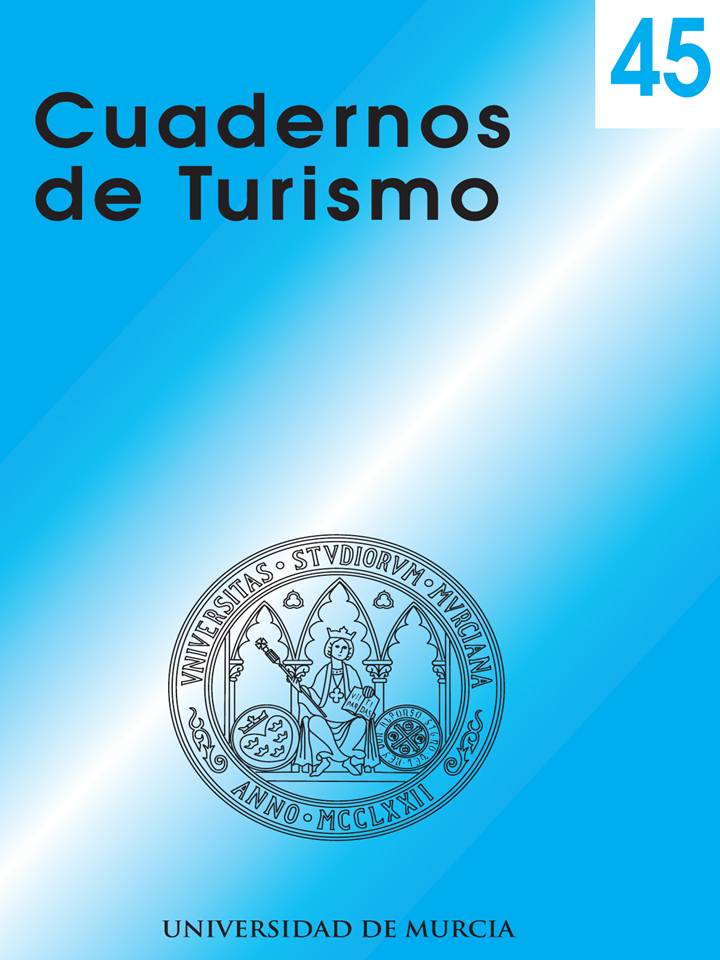The search for spirituality through tourism. Its organisation from the offer side
Abstract
From mid twentieth century we have assisted to a widening in ever-growing tourist possibilities; new ways of travelling have appeared or have diversified their offers (including historical, cultural, environmental, ethnic, etc.) widening thus their action field. We would like to pay attention to a new tourist trend, referred to those who travel around the nets New Age, searching new sacred experiences and spiritual living. We have approached this new process of re-enchantment of the world from the alternative, holistic therapy centers, and all of this kind, which are up to a certain level the links that join this new holistic, transversal and personal spirituality that goes around the places that connect indigenous cultures with global nets, which is creating new coordinates that can be understood as religious.
Downloads
-
Abstract2710
-
PDF (Español (España))3105
-
PDF3105
References
ALBERT RODRIGO, M. (2018): Turismo espiritual. Del viaje interior a viajar por el interior del país,en Rubio, A. y Sanagustín, V. (Dirs.) Turismo Religioso. El camino europeo del Santo Grial y otras rutas culturales para el desarrollo. Madrid, Delta Publicaciones, pp. 73-82.
ALBERT RODRIGO, M. y HERNÁNDEZ MARTÍ, G.M. (2014a): "Lo Sagrado y la Memoria: Hacia una Teoría Sociológica del al Religión”,Revista de Observaciones Filosóficas, nº 17.
ALBERT RODRIGO, M. y HERNÁNDEZ MARTÍ, G.M. (2014b): “Los movimientos psico-espirituales en la modernidad globalizada. Una mirada desde la ciudad de Valencia”, AIBR. Revista de Antropología Iberoamericana,vol. 9 (3), pp. 273-296.
AMIROU, R. (2000): Imaginaire du tourismeculturel. París, Presses Universitarire de France.
ARIÑO, A. (2000): Sociología de la cultura. La constitución simbólica de la sociedad. Barcelona, Ariel.
AUGÉ, M. (1998): El viaje imposible. El turismo y sus imágenes. Barcelona, Gedisa.
BAYONA ESCAT, E. (2015): “Rituales indígenas y otras escenificaciones turísticas en los Altos de Chiapas”, Nueva Antropología, vol. 38 (82), pp. 31-50.
CÀNOVES VALIENTE, G. y BLANCO ROMERO, A. (2011): “Turismo religioso en España: ¿La gallina de los huevos de oro?Un vieja tradición, versus un turismo emergente”, Cuadernos de Turismo, nº 27, pp. 115-131.
CUCÓ, J. (2013): La ciudad pervertida. Barcelona, Anthropos.
CHAMPION, F. (1995): “Persona religiosa fluctuante, eclecticismo y sincretismos”, en El hecho religioso. Enciclopedia de las grandes religiones. Madrid, Alianza Editorial, pp. 705-737.
DAVIE, G. (2011): Sociología de la Religión. Madrid, Akal.
DE LA TORRE, R. (2008): “La imagen, el cuerpo y las mercancías en los procesos de translocalización religiosa en la era global”, Ciencias Sociales y Religión, nº10, pp. 49-72.
DÍAZ-SALAZAR, R. (1994): La religión vacía. Un análisis de la transición religiosa en Occidente. Formas modernas de religión. Madrid, Alianza Editorial.
GALINIER, J. y MOLINIERÉ, A. (2006): Néo-Indiens (Les): Une religion du IIIemillénaire. Odile Jacob.
HERNÁNDEZ MARTÍ, G.M. (2002): La modernitatglobalitzada. Anàlisi de l’entorn social. Valencia, Tirant lo Blanch.
HERNÁNDEZ MARTÍ, G. M. (2005): La difusión del patrimonio cultural y el turismo.La memoria construida. Patrimonio cultural y modernidad.Valencia, Tirant lo Blanch.
HERVIEU-LÉGER, D. (2005): La religión, hilo de memoria. Barcelona, Herder.
HIERNAUX, D. (2000): “La fuerza de lo efímero: apuntes sobre la construcción de la vida cotidiana en el turismo”, en La vida cotidiana y su espacio temporalidad.México, Anthropos y El Colegio Mexiquense, pp. 95-122.
LAFAN, M.F. (1994): “Identité, Mémoire, Patrimonie et “Toursitificación” de nos sociétes”. Sociétés, nº 46, pp. 433-439.
LENOIR, F. (2005): La metamorfosis de Dios. La nueva espiritualidad occidental. Madrid, Alianza Editorial.
LOSONCZY, A.M. y MESTURINI, S. (2010): “La selva viajera Rutas del chamanismo ayahuasquero entre Europa y América”. Religiao e Sociedade, vol. 30 (2), pp. 164-183.
MAFFESOLI, M. (1992): La transfiguration du politique. La tribalisation du monde. París, Le Livre de Poche.
MARDONES, J.M. (1999): “Nueva Espiritualidad. Sociedad Moderna y cristianismo”, Cuadernos de Fe y Cultura, vol. 11. Universidad Iberoamericana.
MORALES GONZÁLEZ, M. (2008): “¿Etnoturismo o turismo indígena?”, Teoría y Praxis, nº 5, pp. 123-136.
RITZER, G. (2000): El encanto de un mundo desencantado. Barcelona, Ariel.
RUIZ, M.A. et al. (2011): “Consumidores alternativos: turismo étnico y espiritual new age en los procesos de reinvención del imaginario urbano en San Cristóbal de las Casas. México”,Pasos. Revista de Turismo y Patrimonio Cultural, vol.5, pp. 289-305.
SHIMAZONO, S. (1999): “New Age Movement” or “New Spirituality Movements and Culture”?”, Social Compass, vol. 46 (2), pp. 121-134.
TURNER, V.W. y GARCÍA RÍOS, B. (1988): El proceso ritual. Estructura y antiestructura. Madrid, Taurus.
TURNER, V.W. (2007): Pasos, márgenes y pobreza: símbolos religiosos de la communitas. Lecturas Antropología. Madrid, McGraw Hill.
TURNER, V. y TURNER, E. (1978): Image and Pilgrimage in Christian Culture: Anthropological Perspectives. Columbia University Pres.
WANG, N. (1999): “Rethinking Authenticity in tourism Experience”. Annals of Tourism Research, vol. 26 (2), pp. 349-370.
Las obras que se publican en esta revista están sujetas a los siguientes términos:
1. El Servicio de Publicaciones de la Universidad de Murcia (la editorial) conserva los derechos patrimoniales (copyright) de las obras publicadas, y favorece y permite la reutilización de las mismas bajo la licencia de uso indicada en el punto 2.
2. Las obras se publican en la edición electrónica de la revista bajo una licencia Creative Commons Reconocimiento-NoComercial-SinObraDerivada 3.0 España (texto legal). Se pueden copiar, usar, difundir, transmitir y exponer públicamente, siempre que: i) se cite la autoría y la fuente original de su publicación (revista, editorial y URL de la obra); ii) no se usen para fines comerciales; iii) se mencione la existencia y especificaciones de esta licencia de uso.
3. Condiciones de auto-archivo. Se permite y se anima a los autores a difundir electrónicamente las versiones pre-print (versión antes de ser evaluada) y/o post-print (versión evaluada y aceptada para su publicación) de sus obras antes de su publicación, ya que favorece su circulación y difusión más temprana y con ello un posible aumento en su citación y alcance entre la comunidad académica. Color RoMEO: verde.





_.jpg)







